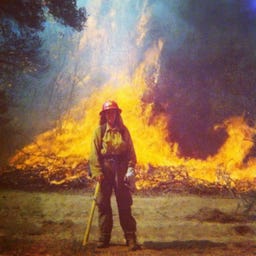Weekly Aggregation
A new weekly missive featuring the best articles and essays on wildland fire and ecology
Hey there: this weekly missive is free. I work really hard on this newsletter and each dispatch takes two to twenty hours. Please consider becoming a paid subscriber. If you cannot afford to pay, but really want to have a subscription, respond to this and I’ll comp you one.
A Roundup of news, articles, and essays engaging with wildland fire:
This New Yorker piece by M.R. O’Connor is a beautiful reflection on wildland fire written by a journalist who embedded herself on a type-2 crew. I have a lot of criticisms about outsiders writing about fire, but this piece (and its writer) deserve none of those. O’Connor trained and worked on a crew, but she kept her sharp writer’s sense of observation. She also interviewed hotshots, scientists, and fire personnel. This piece isn’t only about megafires; it’s about the mental health issues amongst wildland firefighters— how they’re underpaid and at high risk for PTSD and lung cancer. O’Connor does a wonderful job of synthesizing lots of information with very few words. (I did find one factual error in the third paragraph: fire doesn’t burn faster uphill because air rises, but because it preheats the fuels ahead of it. I have to point that out because I am so, so nitpicky).
High Country News published this piece on how wildland firefighters are struggling with homelessness. Way back when, I used to camp out in the summers to save money rather than rent an apartment. Way back when, I was being paid almost the exact same wage that wildland firefighters are being paid now, which has of course increased the risk of homelessness. This needs to change.
Biden’s new infrastructure bill directs $3.3 billion towards wildland firefighting. One of the most prominent changes here is that wildland firefighters will no longer be categorized as “forestry technicians.” Many seasonal employees will have the opportunity to become permanent employees, which has its drawbacks and benefits. Much of this money has been allotted to reducing fuel loading, but we’ll see how that goes.
It’s clear that rx burning prevents catastrophic burning in many areas, but funding has always been minimal. This Los Angeles Times article outlines how far behind agencies are lagging on “treating” public lands, and personally I think it’s the perfect argument for putting fire back into the hands of communities.
Boulder County wildland firefighters are seeking better pay and benefits. A lot of the discussions surrounding wildland firefighter pay and benefits focus on federal agencies, but a large percentage of wildland firefighters work for counties and contractors.
Thank you so much for reading! Look out for another dispatch on Sunday morning. And please comment below and share your thoughts!




